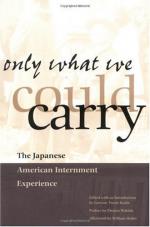|
This section contains 278 words (approx. 1 page at 300 words per page) |

|
Following the liquidation of their personal assets, Japanese residents were placed on buses or trains, escorted by armed guards, to one of twelve temporary reception centers, officially known as assembly centers. Many of these assembly centers were hastily converted racetracks and fairgrounds where Japanese families were sometimes housed in old horse stalls. These hastily constructed apartments were drafty and not well suited to privacy. The walls were paperthin and in most cases did not reach all the way to the ceiling. The quarters were cramped and poorly ventilated, and as Yoshiko Uchida describes, still carried reminders of their previous occupants:
The stall was about ten by twenty feet and empty except for three folded Army cots lying on the floor. Dust, dirt, and wood shaving covered the linoleum that had been laid over manurecovered boards, the smell of horses hung in the air, and the whitened...
|
This section contains 278 words (approx. 1 page at 300 words per page) |

|




